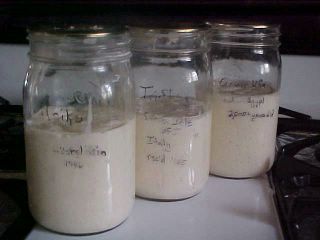Monday, April 25, 2005
Refocusing
Manager and I spent a bit of time talking about the direction the Cracked Cauldron is taking, and ways to move it back on track.
We've been pursing alternative sources of funding - so far with minimal luck. Most potential investors keep looking at this as if it were a franchise, or an established chain and expecting us to dig into dwindling poackets to buy someone else's study that isn't targeting our customers or their needs. We've spent more than a year talking to the very people who will buy our breads and goods, testing our baked goods, and refining the recipes to suit our future customer's tastes. You can't buy a study like that - it takes far too many man-hours, and way too much time baking and talking.
We've talked to potential local suppliers, and we know our local market extremely well - both from the supply end and from the demand end. And we're the yummy middle.
It'll take her a while to run the new numbers, not just for the revamps, but new numbers for the new data we've gotten for the original spreadsheets and cash flow plans.
Part of the revamping was caused by new laws passed in the legislature which will cause certain basic operating costs to increase - some of them substantially. One of those is the liability insurance, which, if we're interpreting things correctly (thanks to events like the woman who sued Wendy's for the finger in the chili) means an increase of almost 1/3 the previous costs. Security requirements for small businesses have also altered (to the higher end of the dollar scale), and with the substantial increase in gasoline prices, we'll have to figure that will effect the bottom line on the delivery of supplies, not to mention their increased cost. We've cut out as many middle men as possible in order to keep prices down, but even they will feel the gasoline pinch.
If we'd been able to get the funding 8 months ago, as we'd planned, we might have to do some minor shifting to cover these increased costs, but getting them added on to the opening expenses is making it seem very difficult.
Manager doesn't want to let go of opening the Cracked Cauldron because she knows, by hard personal research, that it will succeed. It's just convincing these people who are accustomed to operating from an old (and dare we say outworn?) template for operating a business that our methods are sound and will prove exceedingly successful. All she needs is a chance to prove it.
If the county health codes were more business-friendly, she'd be able to operate out of our home kitchen. This is a time-honored avenue many established bakers were able to use to get their businesses going (can you say Mrs. Field's?), but that's closed off to us here. The remodeling expenses to bring the home kitchen up to minimal county health codes would cost almost as much as opening in a more commercial fashion, assuming our little town would even allow us the zoning variance, given our proximity to a public school. Our property abuts the school grounds, not even an alleyway between us, as there is for the little bookstore just east of the school.
So, refocusing, refiguring, and plotting the future of the Cracked Cauldron.
There is the remote possibility that Manager may table opening the Cracked Cauldron as planned in Oklahoma City because of the regulatory difficulties and expenses and consider opening it elsewhere more amenable to a small business.
There's also the remote possibility of going into it backwards - marketing the cookboooks, accessories, local artists' art, and promoting local performers, then expand into the coffeeshop, then finally expand into the actual bakery.
We attended the Oklahoma Festival of the Arts this past weekend and noticed a desperate need to promote local artists in a local venue - something we were planning on adding to the Cracked Cauldron, but maybe we should start there and work our way towards the bakery? Most of the artists at the Festival of the Arts were from out of state. Many of our favorite artists weren't present at all. Some of them will be at the Paseo Arts Festival in a few weeks.
Our original plans were to start the bakery - all the bells and whistles: artisan breads, pastries, cookies, meat pies, cakes, muffins, coffees, with stage room for local performers and wall space for local artists.
Expansion would encompass extended hours, an expanded menu, and - accessories: more art - not just wall art, but sculptures and even "bohemian" style handmade clothing, jams and jellies and bread spreads and condiments and salad dressings, signature coffees, better stage room, and sponsoring artistic events.
These things would not only bring in more customers (which would bring more people into contact with the working homeless problem and help us fund a resource center for that cause), it would hep raise the income and exposure of the artists (many of whom are borderline working homeless themselves).
Too many potential investors hear "bakery" and think "failure" because they've erroneously associated it with "delicatessen", which in turn brings in "restaurant". They know the numbers for restaurants, and many aren't willing to enter what is a risky business. They don't realize a bakery is different in many ways from a restaurant - and apparently they either gloss over the differences pointed out in the business proposal or they assume Manager got it wrong because of her youth. The figures for small bakeries are much more promising than those of restaurants, and the durability of small bakeries is well proven across the country. Big commercial bakeries are a different category again.
Perhaps because Oklahoma City isn't a "foodie" city (we can't buy Meyer's lemons or blue potatoes at either of the Farmer's Markets - yes, we only have 2, as large as we are, and one is seasonal and only open limited hours on some weekends), the mindset here just isn't prepared for a business as simple and radical as the Cracked Cauldron.
Manager will keep trying, though, even if it means completely revamping how she'll accomplish her goals.
One way or another, through unfriendly regulations, laws, and all, the Cracked Cauldron will exist.
We'll keep blogging about it. Maybe someone in some other city or state will find our trials and tribulations and triumphs interesting.
Monday, April 18, 2005
Summing Up Sunday
So, the bread was a smashing success. I brought it to a school and let the faculty and students sample it. They all loved the look of the bread, and most said they'd buy it for the novelty look alone. Others said they'd buy it for the taste, after they ate some.
A few disliked one layer or the other, and everyone had a favorite layer. The beet bread ranked just above the tomato bread, and that sort of surprised me. I thought the tomato bread would be the hands-down favorite with the beet bread dead last.
Don't get me wrong - I like all the layers of this bread. Beets are not popular around here, so I thought the beet bread would rank much lower. Most people commented on the color (sort of a deep mauve color tending towards red) and the spiciness. The beet bread was flavored with tarragon.
The tomato bread portion was seasoned with cinnamon basil, and was the second most favorite. People commented on how they liked the more intense tomato flavor - i used garden grown tomatoes and a bit of tomato paste.
I need to try garden fresh carrots, because storebought ones are too mildly flavored to punch strongly past the yeast, although the thyme and dillweed did boost it enough that some carrot flavor was distinguishable.
And the spinach portion of the bread was liked by most people until they were told it was spinach. Most of the teens immediately scrunged up their faces and said, "Eeew!" then said they'd eat it in this form - as part of the Il Gianfornaio, but wouldn't buy a loaf of just spinach bread. The adults were half and half - half liked the spinach bread, half reacted like the teens.
before most of them had their third bite, they were offering suggestions for accompaniments with the bread: cream soups were high on the list but a large number thought they'd like it with a southwestern chicken stew or a beef stew, or as a sandwich topped with cream cheese and smoked ham or peppered turkey, or with some sharp mustard and cheese.
I think this bread will be another popular one in the Cracked Cauldron. And really, it's an easy bread to make in a bakery, when we're making all these other vegetable breads anyway.
I'm still convinced it would be much better sized like cinnamon rolls, individual sized breads.
As for the personal cheffing job Manager did yesterday while I played with dough: it was very succesful. The patron was pleased enough to pay her a 32% tip, and was impressed that everything was made from scratch, from the fresh spinach and artichokes in the dip to the dressing for the salad and the bread.
There were only three oven dishes: the cheesecake, the bread, the dip; in that order, so it wasn't as difficult as it seemed.
Manager allowed the family and guests to come into the kitchen while she prepared the meal and answered their questions.
They seemed to consider the meal preparation one of the highlights of the dinner party, and appreciated the friendliness Manager displayed as she cooked for them.
This was a birthday party for a woman who turned 50, and the sister who was sponsoring the party wanted their mother to enjoy the party rather than cooking for it as she usually did. Manger said the mother commented several times about how nice it was to watch someone else cook.
Then Manager came home just in time to taste the Il Gianfornaio.
Sunday was a productive positive day in the adventures of the Cracked Cauldron as it wends its slow way towards opening.
Sunday, April 17, 2005
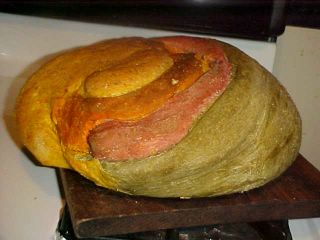
The finished Il Gianfornaio. When we bake this in the Cracked Cauldron, we'll use a nice bread form to raise it in so it will have a prettier shape. And I think maybe, we'll bake it as small rolls. That would be cute.

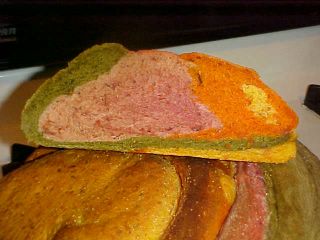
A slice of the bread, showing all four types. I wish you could smell this bread! Better yet, I wish we were open so you could taste this bread! It's every bit as good as I remembered it.

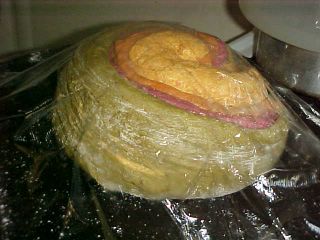
This is the Il Gianfornaio under wraps, on its final rise. There are only 4 layers, as I was unable to find parsnips - even after visiting 6 stores. Oklahoma is not a culinary hotspot. Yet. The layers are, from the outside in: spinach, beet, tomato and carrot.

Il Gianfornaio - redux
This so sooooo a baker's bread!
You can try it at home, but I have some tips for you: Bake your different vegetable breads whenever you feel like it, but take a portion (say 1/5 - 1/4) of it and freeze it. When you have 4 or 5 different vegetable breads frozen, take them out of the freezer, thaw them, roll them out, stack them, then roll up the stack and let that giant roll rise until doubled, then bake it.
If you're crazy enough to mix up 4 or 5 different vegetable breads on the same day, be sure to leave yourself the entire day to do it, and set the first mixes in the frigerator to retard their rising until you are ready to assemble the bread.
Let the cooled bread doughs reach room temperature, then roll each one into a flat rectangle. Brush with water to make the top sticky, and stack each layer of bread dough atop the other. Then starting with the short end, roll the bread up loosely. Let it rise under oiled cling wrap (unless you have a proofer large enough to set this big boy under) until doubled, then bake it.
It is a spectacular loking bread. Pictures are coming, I promise.
An Aussie Bread
I've always wanted to make this Aussie bread I tried once a long time ago called Il Gianfornaio.
It's not a sourdough. It is a rainbow colored bread, composed of several different vegetable breads. The one I had was a round loaf of tomato, beet, parsnip, and spinach bread.
I'm currently making one that will be swirled with a dilly carrot bread, a beet and tarragon bread, a tomato and basil bread, a spinach and sage bread, and a parsnip nutmeg bread. I like the balance of five flavors, and I think it will make a pretty bread. In color order from lightest to darkest, it looks like it'll go: parsnip, tomato, carrot, beet, and spinach.
As soon as I get the camera back, I'll take a picture.
Heh. I was wondering how it would look if I made a nice patriotic bread: a red beet bread, a white potato bread, and a blue cornbread? No artificial coloring would be needed. Of course, the blue wouldn't be as dense a blue as the flag's. Blue potato bread comes out a pale lavendar. Same for a red cabbage and red onion bread, except it's a slightly darker lavender.
You know, blue's a pretty hard color to get naturally in food - a true blue, anyway.
So, while I'm off to check bread, Manager is working at a one off personal cheffing job - a sit down birthday dinner fusion style (which, really, could actually be called American Style, because we Americans have been combining foods and ingredients from many different for generations): an appetizer of artichoke spinach dip, chicken cacciatore, a greek salad with a balsamic vinaigrette, focaccioa with pesto, and two desserts: the Baklava Cheesecake and Raspberry Brownies.
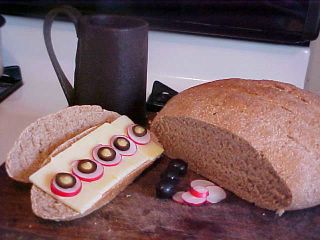
The yummy sourdough bread made from Tri-Pliny. It's fusion - Italian whole wheat sourdough with German belegte brot - a thin scraping of butter, a nice layer of Edam topped with radishes, black olives and a coarse and sharp German mustard, This goes exceptionally well with a nice dark kinderbier, except I don't have any, so I'm substituting Dr. Pepper.

Saturday, April 16, 2005
Introducing 3 Yeast Beasties
In the picture below, I've managed to capture Heike, Tri-Pliny, and Onuri Ufa all at once.
Usually, when I take care of the Yeast Beasties, I forget to take their pictures. What with dividing them, watering and feeding them and sterilizing their jars anew, getting out the camera is far from my mind.
It's not as clearly visible in the photo as it is in person, but Tri-Pliny (in the middle), the youngest of the trio, is also the palest. He has a crisp slightly sour beer smell, and a very creamy color and texture. I haven't baked anything with him yet, so I can't tell you what flavor he has. I'm thinking I make make a Ciabatta or a Focaccio with him later today.
Heike (in the front), is a more tan color, thicker, denser, and with a fruitier smell than beery. She doesn't smell sour at all. Her performance is best with ryes and whole grains, and her breads tend to be dense and firm, slicing thinly and keeping their shape even with multiple fillings. Her bread makes excellent open-faced sandwiches and is a star on the smorgasbord.
Onuri Ufa (in the back) is the darkest of our Yeast Beasties. He's also the oldest by far, tracing his roots to ancient Egypt and the days of the pyramids. He is cantankerous and crotchety, but this latest course of washing seems to have re-invigorated him. I mixed a little Pedialyte in with the feeding water, something I did 20 years ago accidentally. I thought he'd died, and bought water for him and Pedialyte for the children, and grabbed the wrong bottle when I went to feed him. Next thing I knew, he was bubbling away happily.
I haven't given him any more Pedialyte since, but I guess it was just time to give him some more. He seems to need more than just flour and water to keep him satisfied. And he is very slow most of the time to activate for use. He likes barley flours and the older strains of wheat flours the best. He makes great cakes, pancakes, muffins, and little flat loaves of bread. He also makes some of the best crackers ever.
Hmmmm, now I'm curious, I wonder how sourdough Biscotti would taste? I need to try out Tri-Pliny. Maybe I'll make a lovely Biscotti loaf and see what happens.
Thursday, April 14, 2005
Possible Marketing Venue Gone
We've been talking to people who are local organizers for Meetup.com (no link provided) groups, and many were enthusiastic about scheduling their groups to meet at the Cracked Cauldron when we opened. It was a practical match - they needed meeting space, we needed customers and would have space once we opened. Our prices would make us an affordable location for practically all their members.
Meetup.com decided to charge the organizers of these small groups $19.95 a month for the privilege of volunteering to create these groups, schedule meetings, advertise them, and provide content. Not a year - a month. That's over $230.00 a year.
Many of the group organizers I know have stepped down from the position and some groups have disbanded off of Meetup and chosen another online venue instead to reform under.
You know, $15.00 - $20.00 a year is a reasonable amount to seek for forming groups, if the service provided some real services and benefits that weren't provided by several other existing free or nearly free services, but I can't imagine what services would be worth over $230.00 a year. We're talking higher fees than most ISPs charge for internet connection - and that's a tangible service.
The real lesson here for us at the Cracked Cauldron is to be sure that our prices reflect the tangible real services we provide. It's more than the really good and tasty food we'll be offering: meeting space, courteous and prompt service, cleanliness, comfort, entertainment, and the good feelings that come from giving back to the community in tangible ways (feeding the homeless, providing resources for the homeless, supporting local farmers, artists and performers through buying locally, and providing a venue for local artists and performers).
We can charge slightly higher prices on our food for these tangible and real services. But we can't go overboard. In our dollar-savy society, with consumers pinched by ever increasing fees and taxes, it's a fine balance between what we offer and what our customers will tolerate.
We can justify our prices. And as long as we can continue to justify our prices, our customers will willingly pay them.
Tuesday, April 12, 2005
Rescue Remedies for Sick Yeast Beasties
Say you have a sourdough starter, and it doesn't look or smell quite right. Maybe she isn't as vigorous as she once was. You're tempted to throw her out and start all over, even if The Lady has been around since the 1800's.
There are some rescue remedies you can try before you give up.
First, let's review some of the problems a sourdough starter can have.
The hooch - the brownish liquid the forms a top layer on the sourdough when she's been resting a while - isn't floating on top, but is hovering in the middle or even the bottom of the jar. This usually means the flour or the water introduced some element that's making your sourdough sulk. Remember when I complained about Tri-Plint not liking the water I used in his feeding? That's pretty much what the sourdough is doing - sulking. A little extra care and special water or fresh flour can make all the difference.
All sourdough cultures have their own fragrance, and it helps to remember what yours smells like when she's happy. The smell can range from a mild beery fragrance to an intense malty smell. It can be slightly sweet, especially if your flour choice is whole wheat or semolina. Rye flour sourdoughs tend to smell yeasty and earthy under the beer smell. Think dark German beer, and you get a hint of what that will smell like.
If the fragrance is off from normal, a little extra tender care can fix it. If the smell is badly off, the sourdough is also usually discolored - a pinkish tinge to the hooch is the most common discoloration.
And then we have the colored sourdoughs. Normally, a sourdough is a beige color with a clear brownish hooch floating on top. The beige can vary from really pale almost white to tans and even light browns if you're using whole wheat or rye flours as feeding flour. The beige part or the hooch can be discolored. The hooch can hold a pinkish tinge, go grey, or even have a green edging. The thick beige culture herself can turn colors - a parchmenty yellow, pinkish, green, or blue.
I've never been able to cure a blue sourdough.
If you're in the process of capturing a wild Yeast Beastie, and encounter any of these problems before you ever get to learn the characteristics of the culture, you won't have a backup of healthy dried culture vacuum sealed in your refrigerator with which to restart her, so this is what you can do:
1. Pour out all but one cup of your culture and throw the excess away. Don't even feed this part to the dogs. They won't like you if you do.
2. Wash and sterilize the jar.
3. Pour the cup of culture into the sterilized jar and top with bottled water (the cheap drinking water that 45¢ a gallon is fine). Stir it up really well and let it sit in a warm, draft-free place for 3 hours (that incubator you made to activate your culture is perfect).
4. Pour out all but 1 cup of culture, resterilize the jar, and return the cup of culture to it.
5. This time, feed her with 1 cup fresh flour and then fill the jar to within 2 inches of the top with bottled water.
Put her back in the incubator for 6-10 hours.
Pour out all but 1 cup of culture, resterilize the jar, return the culture to the jar with 1 cup of flour and 3/4 - 1 cup bottled water.
Put her back in the incubator for 3-4 hours.
6. If she smells decent, bubbles up within 4 hours, and a layer of hooch forms on top, you're good to go. You can either set her in the refrigerator until you're ready to use her, or use her right away.
This is usually enough to cure most minor sulks and ills. But if she's really sick or contaminated, it can many more such treatments to effect a cure. Sourdoughs are remarkably resilient and hardy. A weekend of extra care and they're usually back in baking form.
Sometimes, though, the contamination is more than finickiness. Stray bacteria in the environment or the allowable contaminants in flour overwhelm your culture, and the weekend regime isn't enough to restore your precious culture back to health and vigor. In that case, proceed on to Step 7:
7. If she's still setting the hooch layer in the wrong place or still smells off or is discolored, repeat steps 1-5. For badly sick or finicky cultures, you may need to try different brands of flour or water and repeat steps 1-5 until she comes out right, and that can take up to a week of washing and incubating every 8-10 hours.
Why yes, it does seem a bit excessive to hover over a culture for a week, setting your schedule by her feedings. Some cultures are worth it, though, for the sentimental value of the culture, for her unique flavor and characteristics, or because she's so old you would feel terribly guilty at killing her after all these centuries.
This is why I highly recommend drying a portion of your starter and vacuum sealing it against future need. Sometimes a culture gets so contaminated she can't be cured, and all you can do is wind the clock back to the earlier piece and branch off anew.
If you can store your dried cultures at a friend's house or even in a bank safe deposit box (cool, dark, dry), then you needn't worry about disasters depriving you of your cherished starter, either. Temperatures over 100º will kill your starter. An electrical failure while you're on vacation can end a promising culture in no time (and leave a smelly horrid mess to clean up).
A little TLC and a decent dried backup can make your relationship with your Yeast Beastie a healthy, happy, long-lasting one.
Monday, April 11, 2005
While We Wait
While we're waiting for the sourdough to rise, I'll share with you some tips on capturing your own wild Yeast Beastie and how to tame her.
As you know if you've been reading this blog for long, we consider most Yeast Beasties to be female, but once in a while a male one comes along. So for this post, I'll just call the Yeast Beasties female.
The best way to get a starter is from a baker, especially if you live in a city or near someplace with lots of auto traffic. The exhaust fumes and pollution create nasty tasting starters, assuming you can even get one going.
Don’t give in to temptation and make a starter using commercial yeast – these starters may start out strong, but they tend to lose their rise and go too sour very quickly. I don’t know anyone who had a sourdough starter made with commercial yeast that was stable and useable more than 10 years after it was born Commercial yeast starters have a purpose, and they are quick and reliable, even quite tasty when young. But I'm assuming you want an heirloom Yeast Beastie, one you can share around with friends and keep for decades, a special pet.
If you live in a pollution-free area, by all means try for a wild starter. Put equal parts flour and water (half cup of whole wheat flour and either bottled water or a good tap water) in a quart sized glass jar with a double or triple layer cheesecloth lid rubberbanded on it, set in a warm shady place outdoors. Do not use heavily chlorinated or fluoridated water as this will contaminate or even kill your starter. 70º - 80º is the optimal temperature for capturing wild yeast. It may take a week before a wild yeast “catches” in the feeder. Add a half cup each of flour and water every 24 hours until it “catches” (froths or bubbles with a beery smell). If the feeder smells off or turns funky colors (red, blue, or green), toss it and start again. It may catch the first time, or you may not catch a Yeast Beastie for weeks.
You know you’ve caught a wild yeast when the feed starts bubbling and giving off a beer smell. The smell may be pleasant, sweetish, sort of like chicken soup, or slightly sour. If you brew your own beer, it will smell sort of like mash. When it starts bubbling and smells beery or sour, start the activation feeding.
The first time, throw away all but 1 cup of starter and add 1 cup each flour and water. After the first feeding, you’ll have to decide if you want to keep the excess starter you will get or toss them, because over the next 3 days, you’ll eventually end up with 64 cups of starter (or more!) if you keep them all.
You don't want to use the starter when she's this fresh because the breads won't taste right yet - too mild a flavor, no complexity. Sourdough developes her personality and flavor as she ages.
Divide the starter into 1 cup batches. Either keep 1 batch and toss the rest or put the rest into their own jars (best I’ve gotten was 3 cups starter from the initial feeder of 1 cup flour, 1 cup water) and make multiple batches to share with friends. Feed each batch 1 cup flour and ¾ cup water every 12 hours for 2 days, then wait 24 hours for the next feeding. Make sure you keep the starter at a reasonably even 70º - 80º during this time.
If necessary, set up an incubator: get a styrofoam ice chest large enough to hold all the jars. Carefully cut a small hole in the bottom and invert the cooler over the jars of starter. Set a small lamp with a 25 watt bulb at the hole, and keep a thermometer in it to be sure the temperature remains in the right range. If the lamp has a dimmer switch, so much the better because you may need to dial it to a lower wattage.
Once you've completed the 24 hour feeding, you Yeast Beastie is ready to use for baking. Let it bubble and foam (usually 2-3 hours after feeding but could be as long as 8-12 hours if you have a slow Beastie), then remove the portion with which you’ll bake and feed what remains in the jar. Let the jar sit out at room temperature for 3-4 hours, then cover it with a loose lid and set it in the refrigerator. Because she’s a new starter, the flavor may be a bit raw, but as she matures, the flavor will mellow and develop layers of taste.
The starter is a living creature and needs to be cared for like a pet – feed her regularly. Naming your starter helps you remember she's alive and needs to be treated as such. I have 7, the youngest is 30 years old.
The best care is to use your starter weekly, thus feeding her every week, but you can go as long as a month between feedings with minimal work to reactivate her. You can go as long as 6 months between feedings, but she will need some intensive care to reactivate her at that point.
You can also dry your starter (excellent if you aren’t going to be using her for a long time or if you are shipping her to a friend to share). To do this, feed your starter and leave her at room temperature for 24 hours. Stir in the hooch that forms. Spread a paper thin layer of starter onto plastic wrap and let her dry completely (up to 2 days). Break her into flakes and store her in airtight containers (I vacuum seal mine in small bags). I recommend doing this anyway just in case your starter is accidentally killed (she got too hot, or so badly contaminated you couldn’t cure her). Keep the dried starter in the refrigerator. She will keep for years in a cool dark dry place – centuries even, as that National Geographic article on yeast in 1996(could have been ’97, I don’t have it ready to hand to check) demonstrated.
Later, I'll tell you what to do if your Yeast Beastie gets sick.
Saturday, April 09, 2005
Tri-Pliny
Well, it looks like the washing took care of Tri-Pliny's contamination problems, and he's growing nicely.
I've had him in the fridge cooling down for a few days, and will take him out later tonight to begin the activation process again. By tomorrow, he should be ready to bake with.
If he is, I'll bake a few things and post pictures.
And yes, thank you for pointing out the camera lens was dirty. I've cleaned it so the pictures should be sharper and prettier. Well, clearer, anyway.
Friday, April 08, 2005
Cake
My co-workers were very good about filling in for me while I was volunteering at MedFaire, so I baked them a cake - a lemon spice bundt cake, glazed with lemon and garnished with fresh sweet redbuds.
Redbuds are a fleeting pleasure. I haven't been able to figure a way to preserve them that captures their sweetness and crunch, so I use them generously during their 2 week season.
If you've never eaten redbuds, while they are still in bloom, pluck a few off a tree and snack on them.
Make sure the tree hasn't been sprayed with pesticides!
I brought an extra baggie full of redbuds to snack on throughout the day.
I do have a lovely seasoning blend I use in North African cooking that uses both redbuds and lavender buds. It makes a huge difference in the meal to use spices, flowers, and other seasonings that are native to the country where the dish orginated. And then, I like to play with the flavors - redbud and lavendar muffins, redbud pancakes, redbuds in couscous, redbud pudding, and more.
Tuesday, April 05, 2005
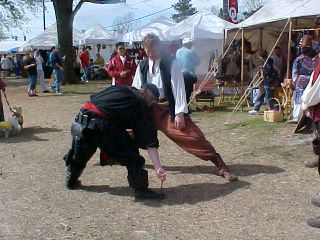
Pirates (more specifically, The Bilge Pumps) playing Stretch after enjoying a sample of Cracked Cauldron cookies.

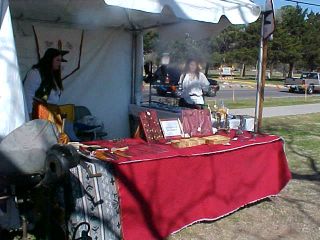
The Booth where we spent most of our time - that's Manager inside the booth, and a volunteer outside it. She came all the way from Virginia to help.

After the Faire
The last post hole is filled and the last bag of trash dragged off. MedFaire is over for another year.
The samples we provided dispapeared quickly. Fortunately, we baked fresh each night, so there were always plenty for the next day.
Y'all have already seen the Pirate Ship Pie and the Castle Turret Pie, and the picture of the cookie stamp we made with cookie.
Those of you who read this blog and stopped by to chat and sample the goodies - thank you! It was a pleasure to meet you.
The cookbook sold about average for this type of Faire. The rennies and vendors were the ones interested in the cookbook, along with the historical re-enactors; and those were the majority of the people who bought the cookbook.
What went well were the business cards.
Oklahoma is not a Foodie place on the cook side of things. Most people prefer ready-made or simple mixes. There was an extremely high interest in the bakery opening. Many people wanted to know where it would be and when we would open so they could stop in and buy the food already made up.
That's pretty much what we expected.
Since the weather was nice all three days, we may have equaled or exceeded the number of visitors as last year - and that was 300,000 people.
We have permission to retell a number of stories, and a few new photos.
This copy of the cookbook will continue to be offered for at least another month, and then it will be retired out-of-print.
A future edition, with all the stories and more recipes and photos may become available later through a better publishing house - one that will offer color photos.
The meeting for this Monday was postponed, so we'll report on that when it happens.
Now, I have to go scrub baking pans and bowls and launder dish towels and costumes.
